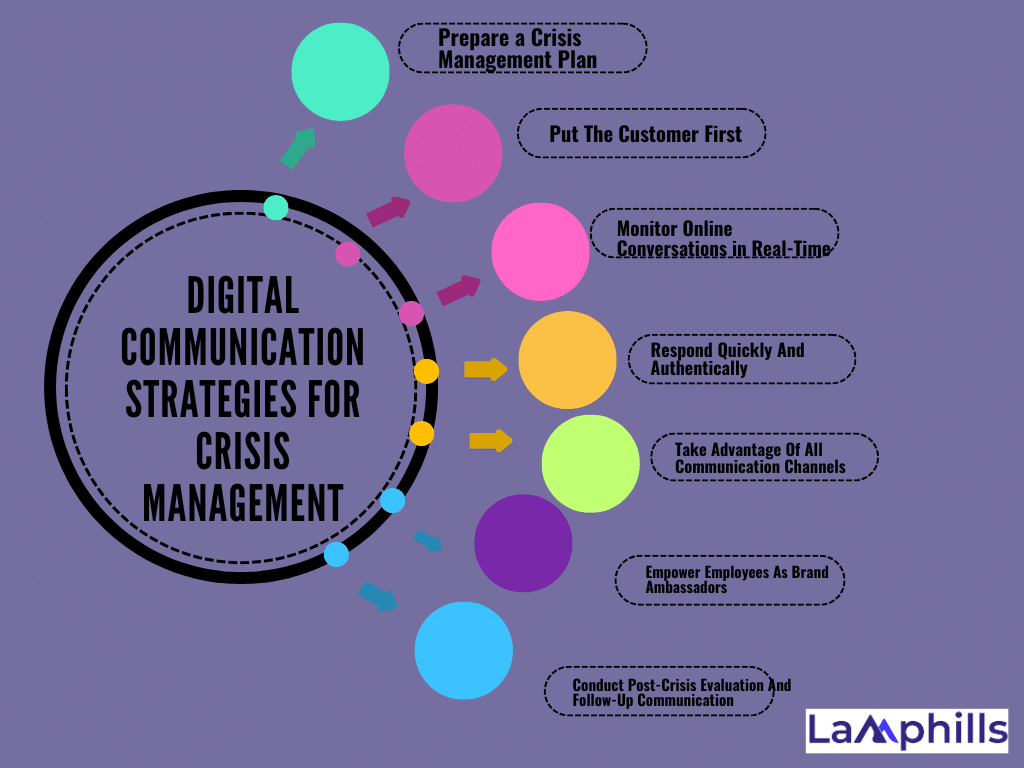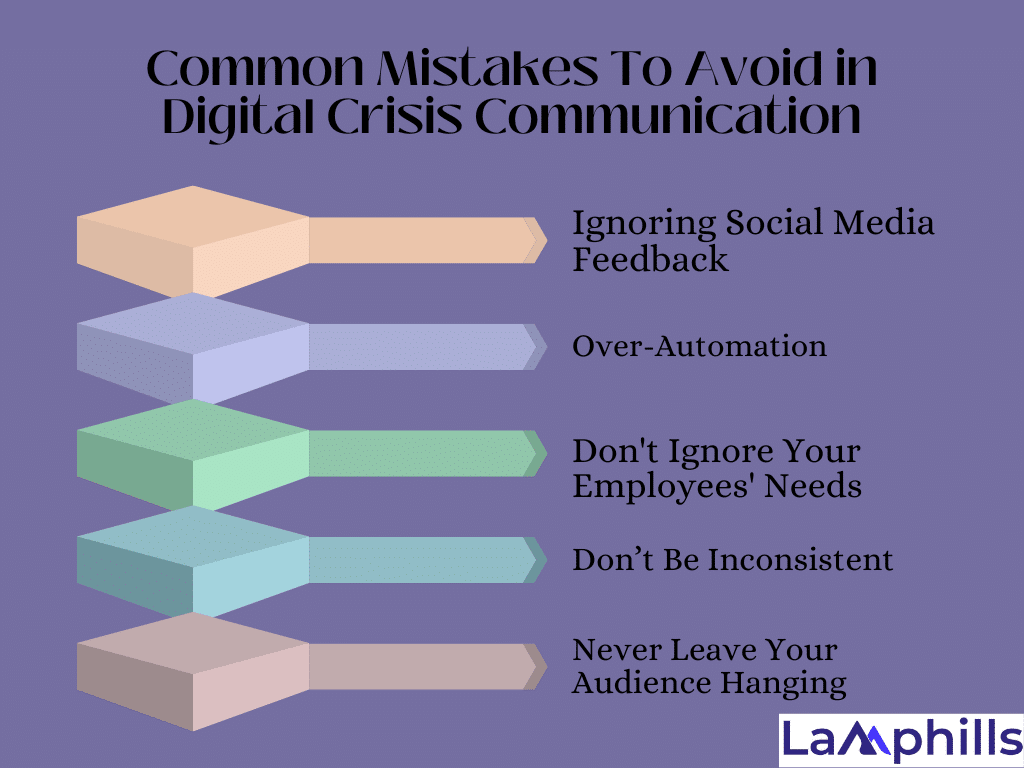One might not have known the slightest thing about what was ten years ago. Since then, digital communication has become a potent instrument for establishing connections between people and organizations all over the world. It has completely changed the way we communicate, work together, and exchange information. Removing geographical restrictions has also created countless opportunities. In the digital age, handling a crisis is no easy task. It may seem like attempting to calm a storm that has already gotten out of control. However, companies can weather the worst circumstances and come out stronger if they have the correct digital communication strategies and tools. This article will teach you the definition of digital communication, crisis management tools, and some useful strategies. Find out more by reading on!
Key Takeaways
- Developing a comprehensive crisis management plan is crucial. This includes social media protocols, communication channels, and designated spokespeople. Testing and updating the plan regularly ensures readiness for unforeseen challenges.
- Utilizing social listening tools like Hootsuite or Brandwatch enables real-time tracking of online conversations. Early detection of emerging issues allows companies to respond quickly, potentially mitigating the impact before it escalates.
- During a crisis, transparent communication can significantly improve public perception. Sharing honest and clear messages with stakeholders helps maintain trust, as seen when companies provide timely updates during sensitive situations like data breaches.
- Tools like Slack or Microsoft Teams are essential for aligning internal teams during a crisis. Quick, coordinated communication ensures that everyone is informed and can act swiftly, functioning as a virtual “war room.
What is Meant By Digital Communication?

Definition of digital communication: This idea, sometimes referred to as data communication or data transmission, is the movement of information or data via a point-to-point (P2P) channel using digital signals.
In this context, data transfer via digital bitstream or digitized analog signal over point-to-point or point-to-multipoint communication channels is meant. These channels come in a variety of forms. Storage channels, computer buses, fiber optics, wireless communication channels, etc. are a few examples.
Any unanticipated event that compromises the operations, reputation, or financial viability of a business is considered a crisis. A misconstrued social media post might set off a PR nightmare, or a data leak that undermines consumer confidence could do the same. It usually boils down to one factor, in my experience, whether or not one can successfully navigate these situations of communication.
I used to work for a small software business that experienced a serious setback when a system bug caused a customer’s personal information to leak. They were about to lose everything, but we worked fast to organize a strategy that included contacting customers, posting about the problem on social media, and issuing a thorough statement. People were so appreciative of the honesty that we received an enormous response. It made me realize that integrity is not only a wise course of action but also an essential component of any crisis management plan.
Key Elements Of Digital Communication

Digital communication has several aspects that set it apart from traditional communication methods. Understanding these crucial elements is critical for properly comprehending the power and capabilities of digital communication. Let’s look at some of its key features:
#1. Instant Interaction
One of the distinguishing characteristics of digital communication is the capacity to facilitate quick and real-time connections. Digital communication, whether through instant messaging, video calls, or live chat, enables people to interact and speak with one another quickly, regardless of geography.
#2. Multimedia Integration
Unlike traditional communication systems, which rely mostly on text communications, digital communication effortlessly blends a variety of multimedia features. Users can exchange and receive photographs, videos, audio recordings, and other forms of media to improve communication and express messages more effectively.
#3. Asynchronous And Synchronous Communication
Digital communication provides the flexibility of both synchronous and asynchronous communication. Asynchronous communication enables people to submit messages and receive responses at their leisure, such as via email or social media posts. Synchronous communication, on the other hand, offers real-time communications using platforms such as video conferencing, allowing participants to engage in discussions without delay.
#4: Accessibility And Convenience
Digital communication has greatly improved accessibility and convenience. With the spread of cell phones and internet access, people may communicate at any time and from any location. Whether sending a brief message during a commute or participating in a virtual meeting from a faraway location, Digital communication offers unmatched convenience and flexibility.
#5. Collaboration And Co-Creation
Individuals and teams may collaborate and co-create more effectively thanks to digital communication. People from all over the world may collaborate on projects, share ideas, and contribute to a common effort thanks to shared documents, cloud-based platforms, and collaboration tools.
#6. Data Preservation And Archiving
Unlike conventional means of communication, which are frequently fleeting, digital communication enables the easy preservation and archiving of conversations and exchanges. This feature allows individuals and organizations to document significant discussions, references, and choices for future reference and accountability.
#7: Personalization And Customization
Digital communication allows consumers to personalize and customize their communication experiences. Individuals can select their preferred communication platforms, personalize notifications, and adjust settings to meet their unique needs and interests.
#8. Scalability And Reach
Digital communication is easily scalable and accessible to huge audiences. Individuals and corporations can communicate with thousands, if not millions, of followers at the same time via social media platforms. This scalability expands the reach and impact of communication initiatives, making it an indispensable tool for marketing, information dissemination, and community participation.
#9: Integration with Other Technologies
Digital communication combines smoothly with a variety of technologies, including artificial intelligence, virtual reality, and augmented reality. These linkages create new opportunities for immersive and engaging communication experiences, revolutionizing how people and businesses communicate and engage with one another.
#10. Global Reach
Digital communication creates a platform for global connectivity. People can connect with persons, organizations, and communities from all around the world with just a few clicks. This global reach fosters collaboration, knowledge sharing, and cultural exchange on an unprecedented scale.
In other words, understanding these key features of digital communication helps us harness its power to its full potential. As technology keeps evolving, we can expect further advancements and innovations that will shape the future of communication.
What Are 5 Examples Of Digital Communication?
Digital communication has revolutionized the way we connect, collaborate, and share information in our daily lives. Let’s explore some key Digital communication examples that highlight the power and impact of digital communication:
- Video conferencing: Tools like Google Meet, Zoom, and Microsoft Teams have transformed remote communication by allowing face-to-face interactions and virtual meetings.
- Social media platforms: Facebook, Twitter, Instagram, and LinkedIn connect people globally, enabling them to share updates, engage in discussions, and build networks.
- Email: It remains a widely used example of Digital Communication method, providing a formal and reliable means of exchanging messages and files.
- Collaborative tools and cloud storage: Platforms such as Google Drive and Dropbox allow users to collaborate on documents in real-time, enhancing teamwork and productivity.
- Social networking platforms: Twitter and LinkedIn offer avenues for professional networking, knowledge sharing, and industry engagement.This is one of the best Digital Communication Examples business can utilise to build a loyal customer base.
Digital Communications Tools For Crisis Management
Crisis management tools are essential for efficiently dealing with unexpected emergencies. These tools provide real-time monitoring of public mood and media coverage. They enable organizations to respond to new issues while maintaining control of the narrative. Crisis management technologies also make complete planning and preparation easier, allowing firms to identify risks and establish strong reaction tactics. Overall, crisis management solutions help to keep activities running smoothly and organizations stable.
Key Features of Effective Crisis Management Tools

Crisis management tools often offer a variety of features, some of which might be more important than others when it comes to dealing with a probing issue. Here’s what features you should look for:
#1. Real-Time Media Monitoring
Expect 24/7 media monitoring across a variety of channels, including social media, news websites, blogs, and forums. Ensure that this platform is the first to notify you of any difficulties that arise. This offers you valuable time to develop a reaction strategy. According to one study, organizations that use real-time media monitoring may identify and respond to potential problems four times faster than those that rely on traditional approaches.
#2. Sentiment Analysis
Not all mentions are created equally. Sentiment analysis enables faster and more detailed identification of the mentioned growth. Responding to a dissatisfied consumer is not the same as dealing with a potential controversy. Sentiment analysis is a key component in crisis management solutions.
#3. Alerting And Notification Systems
Time is of the essence in a crisis. Alerts and notifications guarantee that your staff is fully aware of the issue. Customizable alerts let you prioritize critical mentions.
#4: Reporting And Analytics
In times of crisis, data is your friend. Crisis management systems provide complete reporting and analytics capabilities. They give you insights into how effective your communication was, allowing you to identify and change areas for growth. Furthermore, historical data analysis enables you to discover potential risks and plan for future issues.
Essential Crisis Management Tools

Now that we’ve established what the criteria are for selecting the best crisis management tool, let’s look at the various types of crisis management solutions, each with a specific use case. This includes:
#1. Social Listening Tools
Social listening platforms such as Brandwatch, Hootsuite, and Mention allow you to track what people are saying about your brand in real time. During a crisis, this allows you to recognize emergent difficulties and intervene before they escalate. I recall utilizing Mention when a client received criticism for a campaign that inadvertently upset a subset of clients. We identified the bad feedback early and rectified it before it escalated.
#2. Crisis Management Software
Signal AI and Dataminr are tools that can alert you to possible disasters as they occur. They combine data from a variety of sources, including news websites and social media, to deliver real-time insights. This is especially beneficial for larger organizations or those in areas where public opinion can shift quickly.
#3. Internal Communication Platforms
Maintaining team unity during a crisis is critical. Slack, Microsoft Teams, and Zoom are great for speedy internal communication. When managing a crisis for a non-profit client, we used Slack to coordinate reactions and keep everyone up to date on developments. It was like being in a virtual battle room—messages flowed back and forth, and everyone knew precisely what to do.
#4. Email Communication
Email is still an effective tool for connecting with clients, particularly when you need to reach out directly. During a product recall, I collaborated with a client to create an email campaign that explained the issue, the measures being taken to remedy it, and what customers should do next. It was a more personal method to communicate with those who may not be following the firm on social media.
#5: Press Release Distribution Services
When a crisis necessitates a formal reaction, press release distribution services such as PR Newswire may help you get your message out fast to a larger audience. This is especially useful when dealing with traditional media or trying to put the record straight in a professional manner.
By integrating these tools, organizations can better prepare for, respond to, and recover from crises. Crisis management tools aid in maintaining stakeholder trust and ensuring business continuity.
Digital Communication Strategies For Crisis Management

A crisis is unavoidable in today’s ever-changing, fast-paced, social media-driven world. During one, you must deliver a clear, sincere message to your stakeholders, employees, and consumers. The speed and honesty with which you respond can mean the difference between your organization moving forward and dangerously backward.
Preplanning your crisis communication might help you overcome public relations nightmares. Preparing your leadership and employees for a downturn can help to reduce fear and boost confidence. Whether your crisis is triggered by natural, financial, people, organizational, or technical factors, I have compiled a list to effective crisis communication tactics.
#1. Prepare a Crisis Management Plan
Preparation is the foundation for good crisis management. In the digital age, this entails creating a comprehensive crisis management strategy that incorporates social media protocols, communication channels, essential messaging, and designated spokespeople. The plan should be tested regularly using simulations and modified to reflect current digital trends and potential risks. Having a well-defined strategy in place before a crisis occurs is similar to having a lifeboat on a ship—you hope you never need it, but you appreciate it when you do. Typically, the strategy should include the following information:
- Goals
- Members of your crisis management team
- Who your target audiences are
- Numbered steps to take when a crisis emerges
- How to communicate with the public, such as on your social media channels and in your published content or official statements
- How to prevent the issues from happening or (in the case of natural crises) at least from hurting your company
You can draft your organization’s unique crisis communication plan or download templates from online resources. Even if you use a sample template, you’ll need to customize your plan based on your business needs and crisis type.
#2. Put The Customer First
A crisis frequently evokes strong negative feelings. If your organization makes mistakes, dissatisfied consumers may leave bad feedback on review websites such as Yelp, Google, or social media.
When this happens, avoid playing the blame game. On your social media platforms, including your company blog, try to establish a friendly and collaborative communication environment rather than a defensive one.
If you see bad comments on your social media pages, there are effective strategies to reply to them. Here are some possible responses:
- Offer discounts for a future purchase of your products or services.
- Contact the customer directly to apologize.
- Change the policy that caused the issue.
- Offer a refund.
The research findings suggest that changing corporate policy is the response most customers prefer. Try to find a solution by communicating with your customers. This open communication will help you solve the problems, reduce the negative impact and restore your brand image.
#3. Monitor Online Conversations in Real-Time
Monitoring is critical in today’s digitally connected environment. To anticipate potential catastrophes early, brands must closely monitor online conversations. Real-time social listening solutions like Hootsuite, Mention, and Brandwatch may help you track mentions, sentiment, and trending topics across several platforms. Early discovery enables a faster reaction, potentially preventing the problem from escalating. Tips for Effective Monitoring:
- Use Alerts: Set up alerts for specific keywords related to your brand, industry, or potential crisis triggers.
- Analyze Sentiment: Pay attention not just to what is being said, but how it’s being said — negative sentiment can be an early warning sign.
#4. Respond Quickly And Authentically
In the digital world, speed is essential. A slow answer may convey the impression that the brand is uninterested or unprepared. However, speed should not be at the expense of precision. Even if all of the circumstances are unclear, the initial answer should acknowledge the problem and convey concern.
In a crisis, inaccurate information might exacerbate the situation and cause your target audience to get anxious. Ensure that all information and supporting resources you publish on your website, social media, or offer to journalists as public responses are correct.
Provide frequent updates to eliminate ambiguity, worry, and rumors. If possible, assign a single spokesperson for your company. All the information you put out through different channels ― mass media, social media, and your company website—must be honest, open, transparent, and consistent.
#5. Take Advantage Of All Communication Channels
Communicate with your audience using a variety of methods, including email, SMS, a toll-free customer service phone number, voicemail, your website, and social media.
Provide updates both online and through traditional media. For example, if you need to close or adjust your hours, update your voicemail message and post a sign on the store’s door.
Some businesses continue to operate under a different format, such as selling things online or providing medical appointments via telemedicine. Notify your customers of any modifications or additional alternatives to your services.
Your office or business may be closed, but you should still check voicemail and handle consumer calls. For example, a customer could have ordered a product from you earlier in the crisis but can’t pick it up because your store is closed. In this case, they may call, email, or text you, so keep an eye on all these channels and respond to them.
#6. Empower Employees As Brand Ambassadors
Your employees can be your most valuable assets during a crisis. Empower them with the right information and encourage them to act as brand ambassadors. This internal alignment ensures that your workforce is informed and capable of supporting the brand’s external messaging. Steps to empower employees:
- Internal Communication: Provide regular internal updates to keep employees informed.
- Training: Offer training sessions on how to communicate effectively during a crisis, both online and offline.
- Encourage Advocacy: If appropriate, encourage employees to share positive messages or support the brand on their social channels.
#7. Conduct Post-Crisis Evaluation And Follow-Up Communication
Usually, the intensity of a crisis diminishes over time. When a crisis is over, you can evaluate how your company handled it. Post-crisis actions:
- Debrief: Hold a debriefing session with your crisis management team to discuss the response.
- Gather Feedback: Seek feedback from stakeholders, including employees, customers, and partners.
- Update Your Plan: Revise your crisis management plan based on the lessons learned.
These are some questions you could ask yourself and your team:
- What strengths did we show during this time?
- What weaknesses were exposed?
- How are we doing now?
- What could we do differently next time we’re in a crisis?
You can learn from the crisis by evaluating your performance and responses, allowing you to better prepare for the future. You may also need to work on your reputation and communicate with others afterward.
Trust me, handling brand crises in the digital age necessitates a proactive, agile approach. Brands may effectively navigate crises by thoroughly preparing, closely monitoring, responding fast, and learning continuously, thereby safeguarding their reputation and sustaining customer trust. Mastering digital crisis management tactics is crucial in today’s society because digital platforms may both cause and solve crises.
Common Mistakes To Avoid in Digital Crisis Communication

Here are a few mistakes to avoid in digital crisis communication
#1. Ignoring Social Media Feedback
Ignoring client issues is similar to ignoring a leaky roof: you may get by for a while, but it will eventually cause a lot more harm. Always respond to input, even if it’s only to let them know you’re looking into it.
#2. Over-Automation
Automated answers can be useful, but they should never replace actual human involvement during a crisis. When people are uncertain or upset, a personal touch can help.
#3. Don’t Ignore Your Employees’ Needs
It is customary for businesses to concentrate on external communication during a crisis. Businesses must respond swiftly to stakeholders and their consumer base to avoid a breakdown in loyalty and revenue.
However, do not forget to be upfront with your staff during the process. Uninformed employees can take the brunt of the stress and get overwhelmed quickly.
Take frequent assessments of your employee’s mental health and acknowledge their hard work and dedication to their role during this difficult time. Caring about your workforce encourages a positive company culture and helps propel your business forward.
#4. Don’t Be Inconsistent
Depending on the size of your firm, you may have numerous damage control leaders. To avoid confusion and to prolong the crisis, all spokesmen must offer the same message. Your target audience should be able to tell who’s in charge. Consistent messaging should be open and honest.
#5: Never Leave Your Audience Hanging
During a crisis, it can be difficult to swiftly notify everyone. You should always include a contact person, a responsible department, or an internet link to post information and updates.
However, you should not rely only on one-stop-shop communications. A crisis can be complex, and businesses must be responsive to stakeholders, employees, and consumers who have special questions. Provide the resources and experts needed to relieve everyone’s stress.
Benefits of Using Digital Communication Tools and Strategies For Crisis Management

A single bad mention might quickly escalate into a full-blown crisis. This means that crisis management techniques are no longer a luxury but rather a need for public relations professionals who must be prepared for everything. Here’s how these tools can assist you manage difficult situations and defending your brand’s reputation.
#1. Faster Detection Of Possible Losses
Traditional techniques of crisis detection frequently rely on reactive measures like as news alerts or unfavorable consumer feedback. According to a study conducted by the Institute for Public Relations (IPR), organizations that use a proactive approach to crisis communication report a 67% reduction in crisis intensity. Crisis management technologies provide real-time monitoring across various channels, allowing you to identify potential issues the moment they emerge. This precious head start lets you develop a proactive strategy before a minor issue escalates into a major crisis.
#2. Minimized Reputational Damage
The earlier you can contain a crisis, the less damage it causes to your brand’s reputation. These technologies help you prevent reputational damage by allowing you to respond quickly and effectively. You may avoid spreading bad opinions by responding to complaints quickly and transparently.
#3. Better Decision-Making With Data Insights
The days of depending just on gut feelings to determine how well you handled a crisis are over. Crisis management systems offer useful data insights via capabilities such as sentiment analysis and media monitoring reports. According to Emplifi, organizations that use data and analytics in their crisis communication efforts see a 15% increase in favorable brand sentiment during a crisis.
These insights reveal how viewers are reacting to the scenario, allowing you to personalize communication for maximum impact. Imagine the difference between issuing a generic press release and crafting a targeted message that directly addresses public concerns.
#4. Proactive Crisis Planning And Mitigation
These tools aren’t just for reactive situations. By analyzing historical data and identifying potential vulnerabilities, you can develop a crisis communication plan in advance. This outlines roles, responsibilities, and communication protocols. This way you make sure of a smooth and coordinated crisis response.
Conclusion
Digital communication has changed the way we connect and collaborate. Accepting its potential opens doors, promotes relationships, and creates opportunities. Thrive in this interconnected world by using the power of digital media and communication.
A well-executed digital communication plan can make the difference between a crisis that harms or boosts your reputation. You can manage any storm by being proactive, honest, and equipped with the correct tools.
So, start working on your crisis communication plan right away. Don’t wait for a storm to hit before learning how to sail. Remember that every crisis is an opportunity to demonstrate to your consumers who you truly are when it matters the most.






